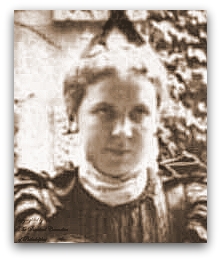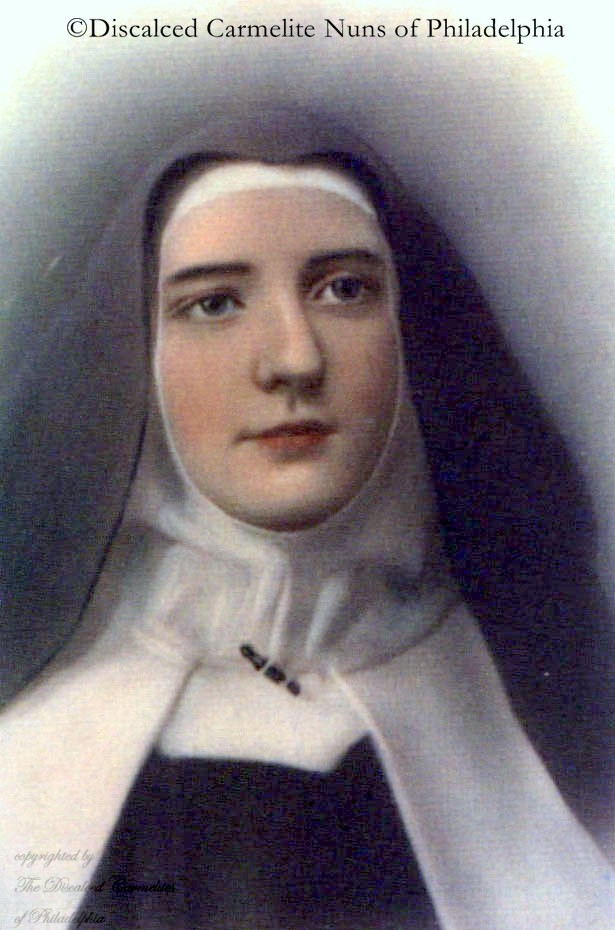St. Therese of Lisieux and Sister Mary of St. Joseph, a Carmelite nun of Philadelphia, - August 30, 2014
 Sister Mary of St. Joseph, O.C.D., of the Philadelphia Carmel On Sunday, March 25, 1877, in Alençon, France, Zélie Martin, a lacemaker with a four-year-old daughter, Thérèse, who was to become St. Thérèse of Lisieux, wrote to her sister-in-law about the transformation of Zélie’s 13-year-old daughter Léonie, who had been abused by the family’s maid:
Sister Mary of St. Joseph, O.C.D., of the Philadelphia Carmel On Sunday, March 25, 1877, in Alençon, France, Zélie Martin, a lacemaker with a four-year-old daughter, Thérèse, who was to become St. Thérèse of Lisieux, wrote to her sister-in-law about the transformation of Zélie’s 13-year-old daughter Léonie, who had been abused by the family’s maid:
“I can’t tell you how many times a day she comes secretly to shower me with kisses. She does absolutely everything I tell her. Now, she’s like a normal child.”
On the same day, in Philadelphia, a little girl was born who was to play a decisive role in making Zélie's little Thérèse known in the English-speaking world. Mary Joseph Daily was born on the feast of the Annunciation. (Thérèse loved this feast “because that’s when Jesus was littlest.” In 1888, Thérèse entered Carmel on the feast of the Annuncation, which that year had been transferred to April 9 because of Lent). Soon after her baptism the baby Mary was dedicated to Our Lady.
Little Mary was the child of a devout Catholic family, who, like the Martin family, lived in the belief that “God must be served first.” Together with Helen Kelly, the future Sister Stanislaus of the Blessed Sacrament, who came to be known as "Philadelphia's Little Flower," she was a member of the parish of the Church of the Gesu in North Philadelphia. She was educated by the Sisters of Notre Dame de Namur. Mary and Helen were close friends, and their futures would be intertwined.
Mary was only six when she understood that she had a vocation to become a Carmelite. (Read a letter--written ten days after Mary was born—by St. Thérèse’s sister Pauline to her friend Louise Magdelaine, recounting how the four-year-old Thérèse had just announced her intention of becoming a cloistered nun. Read also the first letter Thérèse ever wrote, written to Louise on that same day).
 Miss Mary Joseph DailyMary Daily enjoyed her youth. In April 1896, when the little Thérèse, now a 23-year-old Carmelite nun at Lisieux, was entering into her trial against faith, Helen Kelly entered the Carmel of Boston at age 16. In December 1897, less than three months after Thérèse died of tuberculosis, Mary, then aged 20, followed her friend to the Boston Carmel, where she took the name Sister Mary of St. Joseph. The other nuns loved their humble, modest, and affectionate new sister.
Miss Mary Joseph DailyMary Daily enjoyed her youth. In April 1896, when the little Thérèse, now a 23-year-old Carmelite nun at Lisieux, was entering into her trial against faith, Helen Kelly entered the Carmel of Boston at age 16. In December 1897, less than three months after Thérèse died of tuberculosis, Mary, then aged 20, followed her friend to the Boston Carmel, where she took the name Sister Mary of St. Joseph. The other nuns loved their humble, modest, and affectionate new sister.
 Sister Stanislaus of the Blessed Sacrament, O.C.D.
Sister Stanislaus of the Blessed Sacrament, O.C.D.
Sister Mary and Sister Stanislaus were living together in the Boston community when Thérèse’s Story of a Soul first appeared in French. A copy found its way to the Boston Carmel, and Sister Stanislaus translated it into English. In 1902, when both were chosen, along with three other nuns, to found a Carmel in Philadelphia, Sister Stanislaus was already a central figure in the American movement for the beatification of Sister Thérèse.
Sister Mary had been blissfully happy at the Boston Carmel, and accepting the move was not easy for her. On March 25, 1902, her 25th birthday, she had made a vow to be the lifelong servant of the Blessed Mother. She had a brave missionary spirit and a strong desire to partiicpate in the salvation of souls, and, in this spirit, she accepted everything.
But Sister Mary must have been happy to live closer to her family of origin. Carmel in Philadelphia: The First Hundred Years reproduces a photograph of Rose Daily and Mrs. H. Daily, presumably Mary’s mother and sister, kneeling in the public chapel of the first house on Poplar Street. In Philadelphia Sister Mary and Sister Stanislaus were assigned together as portresses, who answered the door and welcomed visitors and workmen to the monastery. Both seized on the opportunity this office gave them to spread devotion to Sister Thérèse among the people of Philadelphia. As early as 1910, Father Thomas Taylor, testifying at the diocesan process for Sister Thérèse, included the Carmel of Philadelphia in the list of places where Therese was loved. After Sister Stanislaus died in 1911, Sister Mary redoubled her efforts in the apostolate of making Sister Thérèse known. From a room in the old house before the present monastery was built, she ordered all kinds of materials from Lisieux, prepared catalogs, and distributed these items all over the United States.
 "Hill Top," the first house on the site of the Carmelite Monastery in Oak Lane, Philadelphia
"Hill Top," the first house on the site of the Carmelite Monastery in Oak Lane, Philadelphia
From that room she sent out $3,000 worth of materials related to Sister Thérèse. Sister Mary rejoiced to see Pope Pius X sign the decree introducing Thérèse’s cause at Rome on June 10, 1914.
God did not allow either of the two young women who had worked so hard to make Sister Thérèse known and loved to witness her canonization on earth. In the spring of 1915, Sister Mary, at age 38, showed signs of acute tuberculosis, the same disease from which Sister Therese died. Rest did little for her, so she continued her work until January 1916. Like St. Thérèse, she suffered acutely from fever, coughing, and nausea. She said these were signs that “Jesus is coming soon.” (During this period the Apostolic Process, at which witnesses testified about Sister Thérèse’s sanctity, was going forward in France; St. Thérèse’s novice, Sister Martha of Jesus, testified on Tuesday, February 8, 1916). On Friday, March 10, 1916, five years to the day after the death of her friend and fellow apostle, Sister Stanislaus, and two weeks before her thirty-ninth birthday, Sister Mary of St. Joseph was received into perfect union with her Divine Spouse.
I close by quoting from the booklet which furnished most of my information, Carmel in Philadelphia, The First 100 Years, written by Allan Dash and published by the Discalced Carmelite Nuns of Philadelphia in 2002:
“The two nuns were missionaries for souls, and had both made the Philadelphia Carmel a center of devotion to St. Thérèse by the early 1900s. They had knelt side by side for their first holy communion, and both went willingly to their eternal reward in the prime of life. They never saw the monastery they had come back to Philadelphia to build, but they left a legacy of personal holiness which became part of the foundation of the Oak Lane Carmel.”
May the Holy Spirit which moved these two young women to offer themselves as channels through which the grace of God drew so many souls to the Trinity move us, too, "to help souls." We rejoice to continue their apostolate today. Sister Stanislaus of the Blessed Sacrament, Sister Mary of St. Joseph, pray for us!
[My fervent thanks to the Discalced Carmelite Nuns of Philadelphia, who generously opened their archives to permit me to research this article. For more information, visit their site "The Discalced Carmelite Nuns of Philadelphia"].
Reader Comments